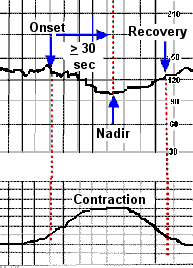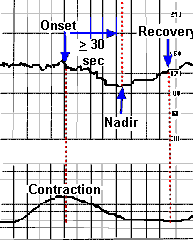A deceleration is a decrease in the fetal heart rate below the fetal baseline heart rate. An early deceleration is defined as a waveform with a gradual decrease and return to baseline with time from onset of the deceleration to the lowest point of the deceleration (nadir) >30 seconds. The nadir of the early deceleration occurs with the peak of a contraction.

A late deceleration is defined as a waveform with a gradual decrease and return to baseline with time from onset of the deceleration to the lowest point of the deceleration (nadir) >30 seconds.


The onset of the deceleration occurs after the beginning of the contraction, and the lowest point of the deceleration occurs after the peak of the contraction.
The difference in the timing of early decelerations and late decelerations relative to the contraction may be explained by the underlying mechanism for each of these decelerations.
Early decelerations appear to be caused by vagal discharge produced when the head is compressed by uterine contractions. The onset and depth of early decelerations mirror the shape of the contraction, and tend to be proportional to the strength of the contraction.
Late decelerations occur when a fall in the level of oxygen in the fetal blood triggers chemoreceptors in the fetus to cause reflex constriction of blood vessels in nonvital peripheral areas in order to divert more blood flow to vital organs such as the adrenal glands, heart, and brain. Constriction of peripheral blood vessels causes hypertension that stimulates a baroreceptor mediated vagal response which slows the heart rate. The time consumed in this two step process accounts for the delay in the timing of the deceleration relative to the contraction.
Late decelerations with good variability (“reflex lates”) are sometimes caused by excessive uterine contractions or maternal hypotension which may be alleviated by correcting the underlying cause. In conditions with reduced placental exchange such as intrauterine growth restriction (IUGR) measures to improve blood flow and oxygen delivery to the fetus may not be as effective.
If oxygen continues to be limited (hypoxia) to the fetal tissues acidosis can develop as result of increased anaerobic metabolism. Significant levels of acid in the blood (acidemia) can suppress the fetal nervous system leading to decreased variability and direct myocardial depression made evident by shallow late decelerations. If myocardial depression is severe enough, late decelerations may be absent all together
Etiologies of Late Decelerations
Excessive uterine contractions
Maternal hypotension
Maternal
hypoxemia (asthma, pneumonia)
Reduced placental exchange as in:
-
Hypertensive disorders Diabetes IUGR Abruption
References:
1. Cabaniss ML ,Ross MG.Fetal
Monitoring Interpretation 2nd ed.Philadelphia,
Lippincott Williams & Wilkins, 2009
2. Harris JL, Krueger TR,
Parer JT Mechanisms of late decelerations of the fetal heart rate
during hypoxia. Am J Obstet Gynecol. 1982 Nov 1;144(5):491-6. PMID:7137235
3. Murata Y, et al. Fetal heart rate accelerations and late
decelerations during the course of intrauterine death in chronically
catheterized rhesus monkeys. Am J Obstet Gynecol. 1982 Sep
15;144(2):218-23.PMID:7114133
4. Gaziano EP, Freeman DW Analysis of heart rate patterns preceding
fetal death. Obstet Gynecol. 1977 Nov;50(5):578-82. PMID:909663
